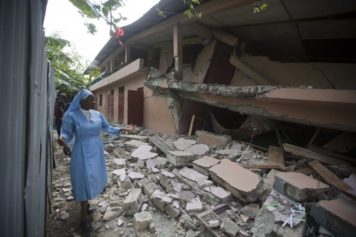As the third anniversary of the devastating Haitian earthquake approaches on Saturday, the international media is filled with stories painting a depressing picture of a nation that has barely made a dent in its massive problems, even after billions of dollars in aid and donations from around the world.
With a death toll well in excess of 300,000 — though no one knows precisely how many people died in the incomprehensible tragedy — the Haiti earthquake was the worst national disaster in the history of the Western Hemisphere, occurring in the poorest country in the region.
Associated Press reporter Jonathan Katz, who had been stationed in Haiti for two and a half years before the earthquake struck, just published a book about the disaster called “The Big Truck That Went By: How The World Came To Save Haiti And Left Behind A Disaster.” The book adds significantly to the collective tale of woe that the media reports weave.
“The earthquake that leveled Port-au-Prince and much of southern Haiti had defied logic, imagination, even superstition,” Katz writes in the book’s introduction, which is excerpted on the website of Boston’s NPR station, WBUR. “How did a magnitude 7.0 temblor — a huge release of energy, but not necessarily catastrophic — prove to be the deadliest natural disaster ever recorded in the Western Hemisphere? Why did an earthquake, of all calamities, strike at the heart of a nation already reeling from so many others? And why, three years after so many countries and ordinary people sent money and help, hasn’t Haiti gotten better? I wrote this book in part to answer those questions.”
But not all dispatches from Haiti are filled with depressing hopelessness.
An aid worker wrote an editorial for the Guardian claiming that these tales of woe, while technically accurate, do not give a true sense of the hope and strength of Haitians.
“If you believe all these comments, the future of Haiti certainly looks depressing. I won’t say the points made in these articles are all wrong, but – as a Haitian living here and talking to people who are desperately trying to change things – I refuse to be disheartened,” the aid worker writes. “The aid Haiti has received has generally been used to support a society left devastated by the massive damage the earthquake caused, and to give a degree of strength and resilience to the country’s already fragile economy. Without this kind of support the situation would be far worse than it is. The funds have contributed to keeping millions of people alive and offering them the chance of a future.”
“What people don’t mention in all these critical articles about Haiti is the daily battle of the average Haitian to make life better,” the writer continues. “During the past three years, Haitians have contributed a huge amount to the reconstruction process, and, since the beginning of the disaster response, solidarity and cohesion among Haitians have been strong and greatly contributed to helping save lives immediately after the earthquake…I am one example. I’m only here today because some wonderful people in the neighborhood pulled me out of the rubble when our Christian Aid office collapsed.”
Another article by The Associated Press also contains elements of hope. This one follows Haitian marathoner Astrel Clovis, a local mechanic, on his daily run through the streets of Port-au-Prince, creatively using the trip to describe the devastation that occurred in various neighborhoods and corners of the city — and the efforts to rebuild those places over the last three years.
“Like virtually all Haitians in the capital of 3 million, the runner’s life was disrupted by the catastrophic earthquake on Jan. 12, 2010,” says the writer, Trenton Daniels. “But a month later he was back on the streets, resuming his routine along with the rest of the country. His daily run is a tour of a capital on a slow mend, a jaunt past what has been accomplished so far and what remains to be done.”


